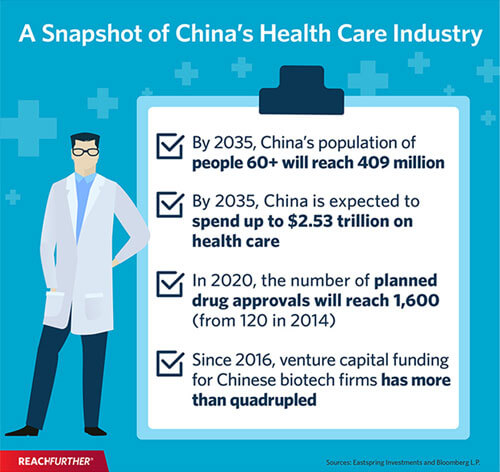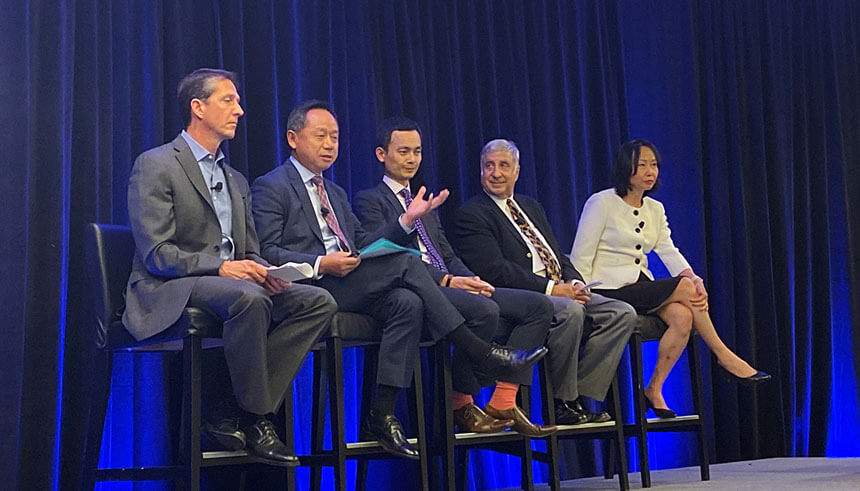US-Asia Business
Finger on the Pulse of China’s Health Care Sector for Businesses
By Melody Yuan

Finding the best ways to integrate your medical products and services for the Chinese market
“If you’re not doing business with China now, I guarantee that you will be in the next 10 years,” says John Cox, president and CEO of FRESCA Medical. He is a firm believer in the business opportunities that are emerging in China’s health care, medtech, biomed and life science industries. “China is going to open a lot of doors for the health care sector, whether in the form of investment for new medical technologies or funding for disease treatment R&D,” he explains.
Cox’s statement is supported by solid numbers, as the long-term outlook for China’s health care sector looks promising. By 2035, for example, China’s senior citizen population (60+ years) is estimated to reach 409 million, more than a quarter of its total population.
“This is going to be more than the total population of the U.S.,” says Andrew Pan, senior vice president and head of China business and strategy at East West Bank. “You have to take into account that China also has some of the biggest numbers in the world in terms of cancer, diabetes and heart disease cases. These numbers are growing fast, and it’s these two factors—the aging population and fatal disease cases—that are pushing China to open their highly controlled and regulated health care industry.” With the cumulative pressures of an aging population, growing middle class and higher rates of diseases, China’s health care industry is poised for change.

In the last five years, China has doubled the amount it has poured into public hospitals to $38 billion and is looking to grow the value of its health care industry to $2.3 trillion by 2030.
For starters, China has set ambitious goals to offer the world’s best health care coverage for its citizens. In the last five years, China has doubled the amount it has poured into public hospitals to $38 billion and is looking to grow the value of its health care industry to $2.3 trillion by 2030. China has also recently updated its drug approval system, resulting in some foreign drugs and medical trials getting approved more quickly in China than in the U.S. According to the Boston Consulting Group, the average drug approval time in China took 35 months in 2011, but has whittled down to 11 months in 2016. For clinical trials, that number has gone from 33 months to just eight months in 2016.
“This is the time to get involved in China, because we’re talking about so many opportunities like exporting new drugs, new medical devices and technologies, such as imaging, robotic equipment, IVD and health care artificial intelligence, to China. We’re talking about introducing biotechnologies like gene therapy and stem cell research. We’re looking for investment opportunities in high-end specialty hospitals, digital health care, including online diagnoses and e-pharmacies, and the list goes on,” says Pan. “And that’s not even considering other examples like food supplements, reproductive care products and plastic surgery services that are also growing in demand for different population demographics.”
Things to consider before entering the Chinese market
While aspects of China’s health care industry may mirror the protocols and regulations of other countries, Grace Fu Palma, CEO and founder of China Med Device, LLC, cautions businesses not to overlook the details.
“Don’t assume simply that because you’ve passed all of the required tests in the U.S. and that you’re FDA approved, you’re prepared to go to China. It doesn’t work that way,” she says.
"You have to take into account that China also has some of the biggest numbers in the world in terms of cancer, diabetes and heart disease cases. These numbers are growing fast, and it’s these two factors—the aging population and fatal disease cases—that are pushing China to open their highly controlled and regulated health care industry.”

As an industry veteran who who has worked to help foreign businesses navigate China’s regulatory environment, Palma talks at length about the evolution of the country’s health care industry from the early ‘90s to its current state. “When I first started, I could roll in a cancer treatment machine without even having to register it officially,” she says. “Then in the 2000s, the National Medical Products Administration (NMPA), which is the Chinese version of the FDA, emerged. Since then, China’s state council has started with one of the biggest health care reforms for the country, by tightening the testing standards and guidelines required to enter the market.”
Given the recent spate of health care reforms and regulatory revisions, foreign companies may find it hard to stay abreast of the many changes in the industry. “When you’re thinking about going to China, you really have to get a good partner, not only in terms of investors, but also in terms of a partner that understands the regulatory environment,” says Palma.
Here are three specific areas that foreign businesses should consider before diving into China.
- Understand China’s Marketing Authorization Holder (MAH)
China’s state council launched a pilot program that allows foreign businesses to gain easier access to China’s pharmaceutical market. This program permits pharmaceutical research and development institutions to gain short-term benefits through licensing technology and pre-arranged sharing with pharmaceutical manufacturers in China. Institutions that obtain an MAH qualification can get the required pharmaceutical marketing license and drug approval number in China more quickly than applying without going through the MAH program.
- Be cognizant of how you classify your medical products/services
Palma emphasizes the need to be culturally aware of how businesses should market their products and services. “Classifications may vary from the U.S. to China, so you need to be able to define your product in different ways, because this could ultimately also affect your product name,” says Palma. “If you accidentally use the wrong Chinese character to define your product, you may not even get entered into the Chinese medical system.”
- Know China’s testing requirements and clinical standards
“My biggest advice is to design your product in phase one with the Chinese requirements in mind and consult an expert while doing so,” says Palma. Because China’s health care regulations fluctuate frequently, Palma stresses the need for businesses to know the entire process and the various approvals needed in order to successfully launch in China.
“There are different clinical pathways that your device and product can go through—have you weighed your options to see which pathway your particular product fits? It’s a lot to consider, and you can’t do it alone,” she says.

“When you’re thinking about going to China, you really have to get a good partner, not only in terms of investors, but also in terms of a partner that understands the regulatory environment.”
Finding Chinese investors to fund your medical products and services
China’s burgeoning health care industry has caused a surge in innovation, especially in the biotech and medtech sectors, where the number of startups has grown tremendously. This level of excitement and activity has also led to a wave of interested investors and attractive venture capital funding.
“Many of the venture capital firms I’ve talked to are looking for more revenue-generating companies at this point,” says Paul DeRidder, MD and president of BioValleyCHINA, Inc., an organization that supports biomedical incubators across China in partnership with U.S. venture capital firms. “Investor sophistication and angel investing have been growing in China, but other investors like high net-worth individuals are also looking for opportunities to invest in medical technology.”
The biggest problem, according to DeRidder, is that many of these investors are not medical experts and don’t have a strong understanding of the space, let alone China’s health care industry. “So, they don’t know whether or not they’re making a good investment, and rely heavily on structured entities and government-sponsored incubators or accelerators like ours to become connected,” he says.
As part of China’s five-year plan from 2016-2020, the government has been highly encouraging private capital investment. The average value of a venture capital deal jumped 54 percent from 2017 to 2018, reaching $40 million, and China-based investors made up 84 percent of all limited partners committed to private equity funds focused on China’s health care.
“The most straightforward way to enter the Chinese market is through partnerships,” says DeRidder. “If you’re a U.S.-based firm, you’re going to have a very hard time getting into the market without someone on the inside helping you. So, partnerships are very necessary to being successful.” When it comes to finding these investors, DeRidder claims that Shanghai had the highest number of investors looking specifically at investing in medical devices, biotech, diagnostics and digital health.
Making contact with China
“I’m sure you’ve heard great stories of success and perhaps a few stories of frustration coming out of doing partnerships in China,” says Cox. “The truth is, doing business and finding partners in China is really about the same as doing those things anywhere else around the world.”
For Cox, he found a Chinese supplier at Medica, a medical convention in Germany. The supplier proved during the convention that they could do a better job than anyone else at producing some parts for Cox’s company. By leveraging their partnership, Cox went on to cofound a laparoscopic surgery company in Hong Kong and used Chinese matching dollars to pay for the R&D.
“It was an amazing opportunity,” says Cox, “and my experience, having now worked in this industry for a while, is that Chinese businesses want to partner with us as badly as we want to partner with them. We all want win-win arrangements. If you’re expecting a third-country labor rate in China, that ship has long sailed, but the value-added benefits, the technology and experience is now at a world-level where you can find manufacturers in China doing a better job than some of the manufacturers here in the U.S.”
Cox outlines three areas where businesses need to exercise due diligence.
- Develop a detailed partnership criterion
“If you’re looking for partners and have already set the criteria required for establishing them, I’d say that’s a good starting point but not the end,” says Cox. “You have to develop those criteria a little more diligently for a Chinese partnership. You’ve got to look for talent and capacity, track records, references and, of course, certifications.” Hiring a third-party vendor to make credit and background checks may sound tedious, but making those preliminary checks can prevent hiccups and save money and time down the road.
- Network, network, network
“Go to the CMEH (China Shanghai International Medical Device Exhibition) convention held in Shanghai. That’s probably the largest meeting I’ve ever attended in my entire life,” says Cox. By going to these conventions, businesses can place a pulse on the current health care industry trends and network with potential partners and investors. “Our FDA also provides a database that lists out all the various manufacturers around the world by category and country, so you can start there if you’d like,” says Cox. “But keep in mind, there’s no substitute for getting on the ground and meeting people in person to develop relationships.”
- Draft a contract that ensures you and your partner are on the same page
“If you’re drafting a contract, you can ask to create it under Hong Kong law, which is more similar to U.S. law,” says Cox. “Many people are open to those arrangements.” By ensuring that both parties are aware of the terms and conditions, as well as setting standards, businesses can audit results using measurable milestones and performance delivery.
“It’s that simple and doesn’t sound much different from doing business anywhere else in the world,” adds Cox.
Regarding the ongoing U.S.-China trade war, Pan believes that the two countries’ GDPs are too interdependent to be economically decoupled.
“In China, there is a word called weiji, that means whenever a crisis hits, opportunities also arise,” Pan explains. “Look at the pressure this trade war has put on China. In previous decades, only the largest multi-billion-dollar companies could afford to do business in China. But, with an agreement for China to become more open to foreign investment and trade deals, there are more opportunities for smaller businesses to enter the Chinese market.”
China’s need to address the growing health demands of its population could further push the government to relax control over its health care industry. “In 2018, there was a very popular film that was released in China called ‘Dying to Survive,’” says Pan. “The movie was about a Chinese patient who smuggled cheap drugs from India to help hundreds of Chinese patients suffering from cancer. Now imagine, despite China’s very strict film censorship, this film was released and generated a lot of discussion. China is aware of the desperate health demands from its own people and the need to grow their health care industry quickly.”
Sign up for the Reach Further Newsletter
We’ll keep you in the know about the latest US-Asia business news and trends.
Suscríbase al boletín Reach Further
Lo mantendremos informado sobre las últimas noticias y tendencias comerciales entre Estados Unidos y China.

